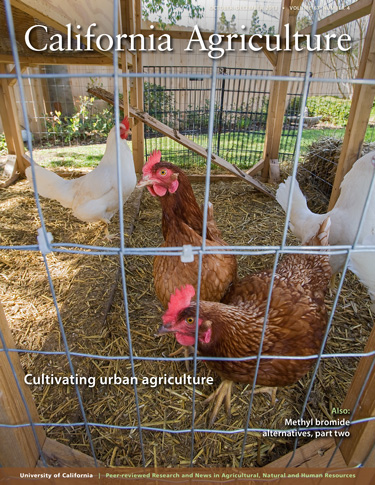All Issues

Cultivating urban agriculture
Cover:
Urban agriculture is growing statewide, as California cities increasingly allow food plants in front yards and under power lines, and bee hives and chicken coops in backyards. To help city dwellers produce food proficiently and safely, UC Cooperative Extension is developing research-based best practices for urban agriculture (page 199). In addition, the California Animal Health and Food Safety laboratory system offers free post-mortems for backyard poultry through the Backyard Flock program (page 203). This diagnostic service enables researchers to collect data on disease trends and can help amateur poultry producers keep their flocks healthy. Photo by Peter Bennett, greenstockphotos.com.

Special issue: Methyl bromide alternatives
Cover:
Growers have long used methyl bromide to essentially sterilize soil, but this fumigant is being phased out due to environmental and health concerns. New research helps identify methyl bromide alternatives to control pathogens, pests and weeds in strawberries (p 139), almonds and stone fruits (p 128), forest nurseries (p 153) and perennial nursery crop stock (p 181), and shows that multi-layer tarps reduce fumigant emissions (p 147). This work is part of the Pacific-Area Wide Integrated Methyl Bromide Alternatives Program, a USDA-funded collaboration of UC and USDA researchers. Shown is a strawberry field in coastal southern California, a region where fumigants are restricted to protect people’s health. Photo by Janet Hudson

New life for conservation banks:
Reforms streamline landmark program
Cover:
Conservation banks enable farmers, ranchers and other landowners to receive income for managing their lands to benefit wildlife. The Golden State established the nation’s first such program in 1995, and has pioneered protection of biodiversity and species at risk. However, since 2009 the number of conservation banks approved yearly has declined to zero, partly due to an unwieldy application process. Now a new law (page 85) and further proposed reforms (page 86) promise to streamline the program. Additional conservation banks could restore critical habitat and protect riparian corridors. Shown is the Thomes Creek tributary coming into the Sacramento River, above Chico at River Mile 326. Photo by Geoffrey Fricker

Hands-on learning:
Healthier choices,
better lives
Cover:
Garden-enhanced nutrition education increases children's fruit and vegetable intakes, helping to address high childhood obesity rates (page 30). Research indicates that long-lasting improvements are achieved through multiple efforts — offering healthy foods on school campuses; teaching nutritional and environmental science in the context of gardening; and involving communities and regional agriculture (see pages 13, 21). Shown are students tending their vertical garden at Downtown Value School in Los Angeles. The school also has a flower and produce garden that goes around the school grounds, a small greenhouse and a worm compost bin. Photo by Peter Bennett/Green Stock Photos.
October-December 2013
Volume 67, Number 4
Volume 67, Number 4





